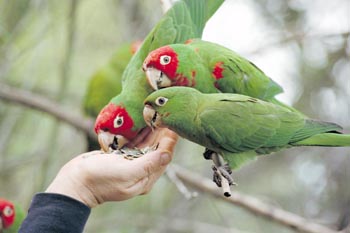![[Metroactive Movies]](/movies/gifs/movies468.gif)
[ Movies Index | Show Times | Silicon Valley | Metroactive Home | Archives ]
Free Birds
One man's love affair with San Francisco's wild parrots is a bittersweet love song to a city
By Richard von Busack
ALTHOUGH San Francisco is one of everybody's favorite cities, surprisingly few good movies have been made about it. Nothing really since Vertigo evokes the city's treachery. The wrong word, treachery—I need a word that defines the difficulty of clinging to a very steep place.
The Wild Parrots of Telegraph Hill is a kind of nature film. It is also a study of one Mark Bittner hanging on to a sheer hillside and holding on to his dream of pure freedom.
Bittner was a rent-free caretaker of a 100-year-old shack on the eastern face of Telegraph Hill. His studio could only be reached by the creaking wooden staircase that links Levi Plaza to Coit Tower. This bay-facing hillside is as vertical a garden as might be seen in a Chinese painting: it consists of a tangle of shrubs and small trees, alive with fuchsias and datura, and there is a fruiting strawberry guava of much interest to the birds.
Bittner came to San Francisco, drawn by his ambitions to become a singer/songwriter. For some 26 years, he bummed around North Beach, but he never found his place. He says: the beats were too down, and the hippies were too up.
This wanderer's favorite poet was Gary Snyder, who commented, "If you want to find nature, start where you are." Bittner began a diary of the feral parrots he saw gathering in the trees outside his window. He opened up his room to a few birds that wanted to live inside: his pet Mingus and an ailing parrot he still grieves for, Tupelo.
Filmmaker Judy Irving shows us the green conures pairing up on branches like lovebirds. We do see one mateless member of a different species. Introducing us to this solitary blue-crowned conure named Connor, Bittner says, "He didn't cotton to being someone's best pal. He tolerates people around him, but he doesn't have anyone he loves." One senses that it is not the parrot he's talking about.
Irving noticed Bittner—thick glasses and a 10-year growth of ponytail—hand-feeding members of a flock of some 30 cherry-headed conure. (I have never seen the cherry-headed conure, but I have often seen what I think are parrots—this film identifies them as canary-winged parakeets—roosting and shrilling in the strip of palms in the median of Dolores Street near Market.)
Like many who come to San Francisco, the conure seem to have been chased away from their original home. Their Ecuadorian habitat has been almost completely deforested to make way for banana plantations.
Up until the United States outlawed the practice in 1992, wild birds were caught and brought in to the country to be pets. Even a tame parrot can be a handful. Bittner has a convincing theory about why flocks of parrots infest America's big cities. People purchased wild conure and other parrots for a bargain price. These turned out to be frightened wild birds that shrieked and did what they could to get of their cages.
Out some window they went, meeting other refugees. Irving offers a sample of alternative theories in interviews with North Beach neighbors. Crate of parrots breaks open at airport. Pet store burns down. Bird smugglers ditch their contraband in midair. Crazy parrot-hoarding lady frees her flock.
The real reason may never be known, but these parrots—almost as smart as crows—have a food supply wherever there are humans. A large flock even calls Chicago home. Bittner notes that temperature is less important to birds than a steady food supply.
Finding the right habitat applies to humans as well as to parrots. Irving films a baffled tourist questioning Bittner, trying to figure out what his angle is.
The stranger is, at first, amused (who does Bittner think he is, St. Francis?). The visitor's amazement deepens when he realizes that Bittner isn't paid by the city to feed these wild parrots. Nor can he figure out what Bittner means when he says, "But the city supports me in a spiritual way." He walks off shrugging: "Huh. Whatever!"
This may be a scene of especial significance for San Franciscans, who, rich or poor, always feel as if there is a rift between them and the Other. The flock of humans that heads to the financial district doesn't mix well with the other flock that only gets up after sundown.
A few avian tragedies Irving captures show the reality behind the glowing fantasy of being a free bird in San Francisco. The air is full of hawks, just as the streets are full of redevelopers.
Everything I got from living in San Francisco is embittered by the memory of the number of times I got evicted whenever the property values went up. The Wild Parrots of Telegraph Hill transcends its obvious lure to bird lovers. In truth, it's an essential movie about San Francisco—how the city reels you in with the dream of a haven and yet how difficult it is to get a really permanent nest there.
[ Silicon Valley | Metroactive Home | Archives ]
Copyright © Metro Publishing Inc. Metroactive is affiliated with the Boulevards Network.
For more information about the San Jose/Silicon Valley area, visit sanjose.com.
![]()

Along Came Pollies: Mark Bittner's feathered friends show up for regular feedings.
The Wild Parrots of Telegraph Hill (Unrated; 83 min.), a documentary by Judy Irving, opens Friday at selected theaters.
Send a letter to the editor about this story to letters@metronews.com.
From the February 9-15, 2005 issue of Metro, Silicon Valley's Weekly Newspaper.